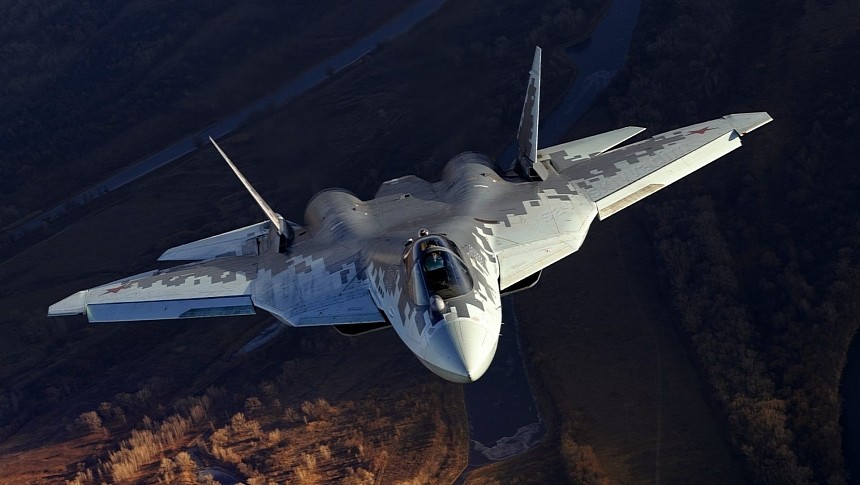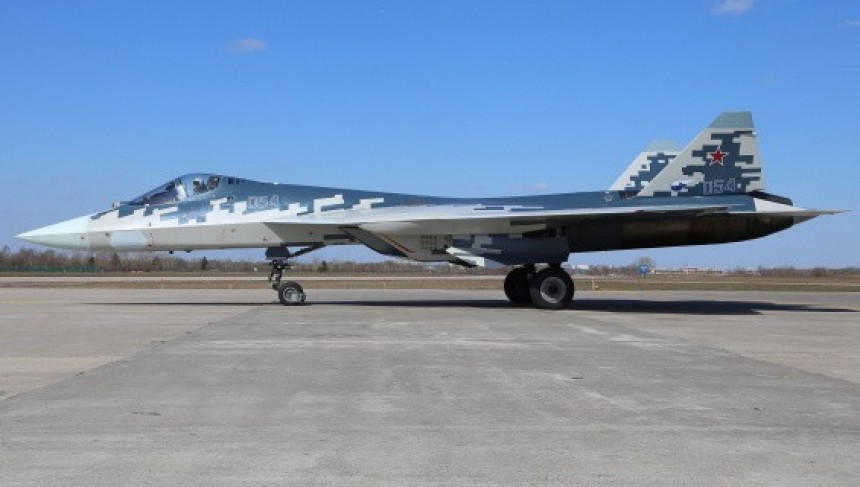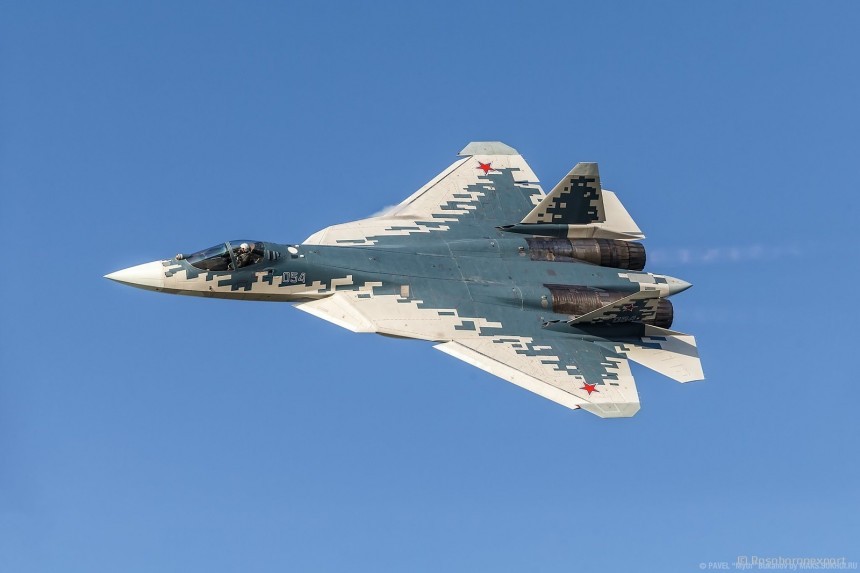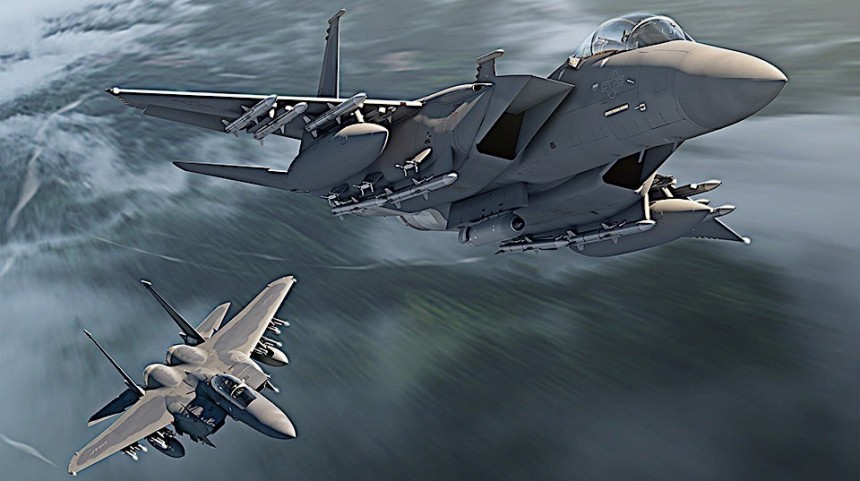You either emphatically love Russia's flagship stealth fighter, or you laugh at every molecule of its construction. There doesn't seem to be much in the way of in-between in these two camps. But in the interests of complete objectivity, we have reasons to suspect some of the claims made about the Sukhoi Su-57 might be the benefactors of embellishment. Some of it might even be complete BS.
Today, let's have some fun with a few hot takes about the Su-57 (NATO Codename: Felon). As it turns out, the only felony this jet's committed so far is theft of our attention. Details inside.
Fifth-generation stealth fighters don't grow on threes. It takes decades and tens of billions in government "cheddah" to manufacture even a single stealth fighter prototype, let multiple squadrons of the things. For all the American public may grumble about high taxes, the result is that Lockheed Martin was able to build almost 200 F-22 Raptor airframes. Even then, some still groan that it's nowhere near enough. LM is also likely to reach 1000 F-35 Lightning II airframes completed by the end of 2023. In the context of fighting World War III one day, those numbers might finally come in handy. But anyone who knows anything about modern Russia knows the exact opposite is the case over there.
Even before the countless global sanctions imposed on Russia prior to its Invasion of Ukraine, the Sukhoi PAK FA, which ultimately became the Su-57, was a wallet-obliterating albatross draped over the Kremlin's neck. That's despite the PAK FA program, internally called the T.50, supposedly being a cost-saving alternative to Russia's first crack at a gen-V fighter, the MiG 1.42/44. Both programs originated in the turbulent post-Soviet 1990s when even the most deep-pocketed Russian oligarch often had issues keeping the factory lights on. Even with an emphasis on cost-saving measures on the part of Sukhoi, the Su-57 is far from cheap. One report from the Eurasian Times detailed how just a single Felon could cost upwards of 4.7 billion Russian Rubles by 2020 estimates. That's upwards of $139.1 million in American money.
Granted, other unofficial estimates peg the jet's cost at between $40 and $50 million per unit. A nice discount over an F-22 Raptor for sure, but who in their right mind thinks a good place to cut costs is with a stealth fighter meant to shoot down the most potent NATO jet in its arsenal? From either perspective, the Su-57's costs simply don't make sense. This is why it's understandable that only ten production-grade Su-57s have been built, at least as far as NATO is aware.
It also explains why no one's heard a peep from the Su-57 outside of reconnaissance and communications missions during the War in Ukraine. If you ask us, it'll probably stay that way. Lest Russia be caught with its pants down in a potential conflict with NATO.
In spite of practically being the size of a bomber, Russia touts the Su-57 as the country's first operational stealth fighter. At least from a visual perspective, there's good reason to think the Russians are telling the truth. But, as with most things involving the Russian Military, these claims seem to be the victims of exaggeration or downright embellishment. Though the exact nature of the Su-57's radar stealth remains classified, it's believed that its radar cross-section has a figure of between -10 and 1.0 dB(m2). If that sounds pretty solid to your untrained eyes, consider the last-gen F-117 Nighthawk sported an RCS value of -25 dB(m2).
In a contemporary American gen-V stealth jet, a la the F-22 or the F-35, expect this radar cross-section value to measure up to -40 dB(m2) from roughly 27 km (16.77 m). When the math is all said and done, the Su-57's airframe is thought to be almost 1,000 times as observable by ground-based radar systems than an F-35. Or roughly the same radar signature as a F/A-18 Super Hornet without any payload on its underwing pylons. More to the point, key issues like exposed screw heads and rivets have been observed in footage obtained of the Su-57 in flight.
In the world of Gen-V stealth fighters, such oversights are an absolute no-no. Hence why the outer skins of both F-22s and F-35s are engineered to be as smooths as possible with an absolute minimum of protrusions or divots that could break its all-important, ultra-low radar cross-section. Instead of screws, Lockheed Martin utilized aerospace-grade epoxy to bond sheets of radar-absorbent coating onto the skin of the Raptor and Lightning II. It's a brilliant technique that makes one wonder why Sukhoi decided to go an entirely different route.
But if an Su-57 pops up on NATO's radar any time shortly, it really shouldn't come as much of a shock. Compared to the real top dogs in modern stealth fighters, the Su-57's radar stealth might become its Achilles heel, regardless of its fancy thrust vectoring and hypersonic missiles.
A couple of weeks ago, I was watching gameplay of an Su-57 duking it out with a fourth-generation F-15E Strike Eagle in the DCS World military simulator. Without spoiling too much, the plucky F-15 put up a good fight. Being able to nearly match the super maneuverable Russian superjet before taking a few hypersonic air-to-air missiles to the face. Now, this all needs to be taken with a grain of salt because it's just a video game. But if you ask us, the latest set of upgrades to the F-15 platform might make the fight considerably less one-sided in a real-life setting.
The new Boeing F-15EX Eagle II isn't just a restomod with wings. Although its new General Electric F110-GE-129 engines do pack a mean punch compared to the Pratt & Whitney F-100s used with the old Strike Eagle. But the upgrade that arguably matters the most in regard to fighting a Russian stealth jet is the tentative addition of an all-new American air-to-air missile. The AIM-260 Joint Advanced Tactical Missile (JATM) from Lockheed Martin is much more than a counter to Russia's Vympel R-37. It's a screaming, Mach-5-capable bruiser of a machine built to counter enemy fighters with similar stealth capabilities to its host jet.
With all the factors accounted for, including the Su-57's questionable stealth, it's not hard to envision these two jets engaging in the most intense dogfight in what must be 50 years. Heaven forbid it becomes a reality for all the collateral damage, but you can't say the Su-57 is a slam dunk to shoot down the latest F-15 derivative ten times out of ten. In all probability, things are down to be far more evenly matched. Besides, all it'd take for the tides to turn in the F-15's favor is for the Russians to simply run out of missiles, citing the exceedingly high cost.
Here's hoping we never have to find out which of the two jets would win in a dogfight. But something tells us it'd be a lot less one-sided than some would give it credit for. For every advancement in military tech, there's always a countermeasure to stop it. Remember that.
The Su-57 won't even reach 40 production examples.
Even before the countless global sanctions imposed on Russia prior to its Invasion of Ukraine, the Sukhoi PAK FA, which ultimately became the Su-57, was a wallet-obliterating albatross draped over the Kremlin's neck. That's despite the PAK FA program, internally called the T.50, supposedly being a cost-saving alternative to Russia's first crack at a gen-V fighter, the MiG 1.42/44. Both programs originated in the turbulent post-Soviet 1990s when even the most deep-pocketed Russian oligarch often had issues keeping the factory lights on. Even with an emphasis on cost-saving measures on the part of Sukhoi, the Su-57 is far from cheap. One report from the Eurasian Times detailed how just a single Felon could cost upwards of 4.7 billion Russian Rubles by 2020 estimates. That's upwards of $139.1 million in American money.
Granted, other unofficial estimates peg the jet's cost at between $40 and $50 million per unit. A nice discount over an F-22 Raptor for sure, but who in their right mind thinks a good place to cut costs is with a stealth fighter meant to shoot down the most potent NATO jet in its arsenal? From either perspective, the Su-57's costs simply don't make sense. This is why it's understandable that only ten production-grade Su-57s have been built, at least as far as NATO is aware.
It also explains why no one's heard a peep from the Su-57 outside of reconnaissance and communications missions during the War in Ukraine. If you ask us, it'll probably stay that way. Lest Russia be caught with its pants down in a potential conflict with NATO.
Is it even really a stealth jet?
In a contemporary American gen-V stealth jet, a la the F-22 or the F-35, expect this radar cross-section value to measure up to -40 dB(m2) from roughly 27 km (16.77 m). When the math is all said and done, the Su-57's airframe is thought to be almost 1,000 times as observable by ground-based radar systems than an F-35. Or roughly the same radar signature as a F/A-18 Super Hornet without any payload on its underwing pylons. More to the point, key issues like exposed screw heads and rivets have been observed in footage obtained of the Su-57 in flight.
In the world of Gen-V stealth fighters, such oversights are an absolute no-no. Hence why the outer skins of both F-22s and F-35s are engineered to be as smooths as possible with an absolute minimum of protrusions or divots that could break its all-important, ultra-low radar cross-section. Instead of screws, Lockheed Martin utilized aerospace-grade epoxy to bond sheets of radar-absorbent coating onto the skin of the Raptor and Lightning II. It's a brilliant technique that makes one wonder why Sukhoi decided to go an entirely different route.
But if an Su-57 pops up on NATO's radar any time shortly, it really shouldn't come as much of a shock. Compared to the real top dogs in modern stealth fighters, the Su-57's radar stealth might become its Achilles heel, regardless of its fancy thrust vectoring and hypersonic missiles.
Forget the F-22, an upgraded F-15EX could shoot down an Su-57.
The new Boeing F-15EX Eagle II isn't just a restomod with wings. Although its new General Electric F110-GE-129 engines do pack a mean punch compared to the Pratt & Whitney F-100s used with the old Strike Eagle. But the upgrade that arguably matters the most in regard to fighting a Russian stealth jet is the tentative addition of an all-new American air-to-air missile. The AIM-260 Joint Advanced Tactical Missile (JATM) from Lockheed Martin is much more than a counter to Russia's Vympel R-37. It's a screaming, Mach-5-capable bruiser of a machine built to counter enemy fighters with similar stealth capabilities to its host jet.
With all the factors accounted for, including the Su-57's questionable stealth, it's not hard to envision these two jets engaging in the most intense dogfight in what must be 50 years. Heaven forbid it becomes a reality for all the collateral damage, but you can't say the Su-57 is a slam dunk to shoot down the latest F-15 derivative ten times out of ten. In all probability, things are down to be far more evenly matched. Besides, all it'd take for the tides to turn in the F-15's favor is for the Russians to simply run out of missiles, citing the exceedingly high cost.
Here's hoping we never have to find out which of the two jets would win in a dogfight. But something tells us it'd be a lot less one-sided than some would give it credit for. For every advancement in military tech, there's always a countermeasure to stop it. Remember that.














